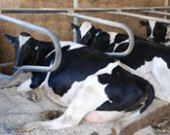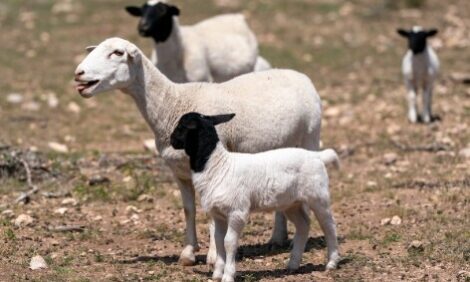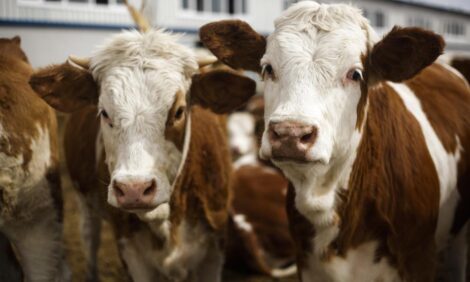



Dairy Crossbreeding: Why and How
There has been renewed interest in dairy crossbreeding as new advantages come to light. Bennet Cassell, Virgina Polytechnic and State University (Virginia Tech) and Jack McAllister, University of Kentucky, explain why producers should consider crossbreeding and how crossbreeding work.
Introduction
Interest in crossbreeding of plants and animals is nearly as old as the science of genetics, dating back to the early 1900s. Dairy breeds that exist in the United States today were formed by use of purebred bulls on a population of less specialized cattle that were clearly not purebred. The primary genetic interest in crossbreeding is in whether animals with genes from different parent breeds perform differently in combination than the average of their parent breeds. The term for crossbred performance relative to the parent average is hybrid vigor, or heterosis.

Formal research on dairy crossbreeding in this country traces back to a U.S. Department of Agriculture (USDA) project that began in 1939. It was followed by a series of crossbreeding experiments conducted by universities and research institutions in the years following World War II. The crosses involved Holstein, Guernsey, some Brown Swiss and Ayrshire, and a few Jersey animals. One experiment in the South included Red Sindhi cattle. The general conclusions were that purebred Holstein cows almost always gave more milk in a single 305-day period than any cross studied; however, there was evidence of heterosis for yields, livability, growth, and reproduction. One or two crosses were more profitable than Holsteins across their lifetimes, but only marginally so. Dairy producers likely looked at the results and concluded that the purebred Holstein cow was close enough to the best choice to eliminate crossbreeding as an option.
Why Consider Crossbreeding Now?
Some things have changed in the last 50-plus years.
- Intensive selection for higher yields and better type has changed the dairy cow, regardless of her breed. Fifty-year-old results may no longer be appropriate.
- Inbreeding levels are increasing in purebred populations.
- Fertility has declined in U.S. purebred dairy populations as a correlated response to selection for higher yields and/or from inbreeding depression.
- The U.S. Holstein is a large animal with some calving difficulty issues.
- Direct payments are made for protein in many parts of the country.
- Organic or low-input dairy production may have special interest in crossbreeding if hybrid vigor reduces the need for medical intervention or if crossbreds respond better as grazing animals than cows of pure breeds.
A survey by Weigel and Barlass, 2003, of U.S. dairy producers already practicing crossbreeding showed that the respondents desired improvements in fertility, calving ease, longevity, and milk component percentages.
Crossbreeding is more widely practiced by dairy producers every year. A crossbreeding program should be seen as a long-term proposition. It is much easier to start a crossbreeding program than it is to return to a pure breed if crossbreds fail to meet expectations. Knowledge of the breed resources available and the strengths and weaknesses of each breed should guide decisions of which breeds to use in a crossbreeding program.
Heterosis alone will not guarantee success in a crossbreeding program. A major portion of success will result from additive genetic merit for different traits that bulls and cows transmit to their offspring. The additive genetic merit of pure breeds and of the animals within those breeds needs to be known and utilized to the producer’s advantage. With proper information, dairy producers who consider crossbreeding can predict the probable performance of the crossbred animals produced by their program(s). There are no easy or quick ways to answer the important questions surrounding dairy crossbreeding, but we can use what we do know and be aware of work in progress to give us further direction.
| Table 1. Population sizes and production of potential breed resources for crossbreeding programs. Management conditions are not the same for different breeds and could affect production comparisons. | |||||
| Breed | Worldwide Population | Bulls Sampled per Year | Average Milk (lb) | Fat % | Protein % |
|---|---|---|---|---|---|
| Ayrshire | 100,000 | 150 | 17,900 | 3.9% | 3.1% |
| Holstein | 25,000,000 | 4,000 | 23,300 | 3.6% | 3.0% |
| Jersey | 1,200,000 | 630 | 17,600 | 4.6% | 3.6% |
| Brown Swiss | 7,000,000 | 80 | 20,700 | 4.0% | 3.3% |
| Normande | 300,000 | 160 | 16,000 | 4.4% | 3.6% |
| Montbeliarde | 330,000 | 170 | 18,000 | 3.8% | 3.4% |
| Swedish Red | 205,000 | 100 | 20,000 | 4.2% | 3.5% |
| Source: Dairy Herd Management, April 2005 | |||||
What Are the Breed Resources?
Table 1 shows seven of the most promising breeds for crossbreeding programs. It includes reasonable estimates of breed averages for production traits, the traits about which we know the most. Population size and young sire sampling efforts, as well as production characteristics are important when choosing breeds. Many other factors, such as body size of mature animals, fertility, calving ease, somatic cell scores, and availability of frozen semen from many bulls with accurate genetic evaluations, also influence breed choices.
Global sire sampling efforts are important in evaluating the potential for genetic progress within a breed. Larger young sire sampling programs enable greater selectivity for combinations of traits and improve genetic progress for lifetime economic merit. Genetic change through selection within pure breeds is and will remain a viable option, depending on trait and species, as a breeding strategy. On that basis, the Holstein breed is in a formidable position. No other dairy breed has the genetic resources to improve lowly heritable traits such as fertility, longevity, and calving ease as does the Holstein breed. The Jersey breed is in second place for number of bulls sampled, while the remaining breeds have smaller programs. However, each of the breeds in the table has strong enough sampling programs to identify genetic material of potential interest in crossbreeding programs.
Dairy producers must be concerned about many traits beyond milk yield in a single lactation. Components – fat and protein - matter, as do health and fertility, calving ease, calf survival, longevity, and other functional traits. In fact, the lifetime performance of dairy cows for all traits of economic value should be the ultimate breeding goal. We know less than we need to know about some of the breeds in Table 1 for these characteristics, but we are learning fast as first crosses of Normande, Montebeliarde, and the Scandinavian breeds appear in U.S. dairy herds. This knowledge will be important to help dairy producers decide which breeds would be most useful in a crossbreeding program. Knowledge of breed strengths – breed additive genetic merit – is only one piece in the crossbreeding puzzle, however.
What Issues Should Be Considered in Crossbreeding?
Crossbreeding programs are long-term decisions. Producers should plan crossbreeding strategies carefully and have reasonable expectations of the process. By the time the first crossbred female reaches breeding age, a decision must have been made as to the breed of the sire to which she will be mated. Within two years after that, the next generation of crossbred female will be reaching breeding age and decisions regarding her mate will arise.
Performance of the first crosses will probably please most producers because 1) producers usually use their second favorite breed on their first favorite breed to produce that cross, and 2) first crosses display full hybrid vigor and tend to be uniform animals.
However, a third breed or a backcross to a parent breed must follow the first cross. A third breed may be a hard choice or even a big compromise if no third breed interests a particular producer. Semen inventories for three breeds or purebred bulls of three breeds are part of rotational crossbreeding programs. Herds composed of combinations of purebreds, two and three breed cross will vary in size, rates of maturity, and perhaps in important management requirements. Further, a backcross will lose about half the hybrid vigor of the first generation crosses. For traits displaying a lot of hybrid vigor, backcross performance may decline, depending on additive breed merit of the pure breeds involved.
Here are some factors to consider when designing a crossbreeding program – given that almost all producers choose to include the breed of cows currently in the herd by default:
-
Breed additive merit: Breeds used in crossing programs need to function well as dairy cows. If a producer doesn’t like a particular kind of cow as a purebred, it isn’t likely that the breed will be suitable in crossbred combinations.
-
Breed complementation: Strengths of one breed can be used to offset or complement weaknesses of another. Example: If a producer considers large size a disadvantage, Holstein–Jersey (HJ or JH combinations, with breed of sire first) crosses are complementary, that is, more desirable than HH animals. If small size is considered to be a disadvantage, H and J crosses are favorable relative to JJ animals but less favorable relative to HH.
-
Within breed selection: The ability to pick and choose parents is just as important for crossbreeding programs as it is in purebred herds. Large population sizes (to provide choices between bulls) and readily available genetic evaluations are essential to rapid genetic progress. A producer who wants to use some unique strain, such as Scottish Highlanders or Dutch Belted, in a crossbreeding program won’t have many choices available when picking AI bulls. There may be no genetic evaluations to guide the selection process at all. These are serious limitations to the utility of such breeds for commercial milk production.
-
Heterosis: As defined earlier, heterosis is the difference in performance of crossbred animals from mid-parent average, that is, the average merit of the two parent breeds, for each trait. If the performance of the crossbred animal is different from the mid-parent average for a particular trait, heterosis exists for that trait. It can be positive or negative, large or small, and it may be considered to be favorable or unfavorable, depending on economic value of the difference. Heterosis for a trait is specific for the two breeds involved in the cross. For example, heterosis for fertility may not be the same in Holstein-Jersey and Holstein-Brown Swiss crosses.
Three-Breed Rotational Systems with Purebred AI Sires
Crossbreeding plans should take advantage of the genetic resources available in pure breeds. Crossbreeding programs using purebred sires from major dairy breeds in Table 1 offer the considerable advantages of genetic evaluations and a wide choice of service sires through AI. Such programs are strongly recommended. No alternative plans, such as using lesser known dairy or dual-purpose breeds or use of crossbred sires, are sufficiently attractive to offset the opportunities available through within-breed selection and use of purebred sires in AI.
Three-breed rotational systems utilizing AI-proven, purebred sires appear most useful to most dairy producers. Three-breed systems, at equilibrium, maintain 86 percent of full heterosis and can reduce large differences from one generation to the next in rate of maturity, mature body size, milk components, and associated nutritional requirements that some two-breed rotational systems may create. Two-breed rotational systems maintain 67 percent of full heterosis and do create bigger “swings” from generation to generation for traits where the two-parent breeds differ greatly.
Both two- and three-breed systems are simple enough to manage, even in very large herds, by placing a different color ear tag in offspring of different sire breeds. The tag will indicate the proper breed of service sire for the animal’s lifetime. For instance, animals sired by Holstein bulls would always be bred to Jersey bulls. Those animals would always be bred to Swedish Red sires, and calves born to those matings would always be bred to Holstein bulls. When established, herds with such a program would have all three crosses at all ages, but decisions regarding service sire would be driven by the simple ear tagging system.
Identification Is Important
While inbreeding is not a major consideration for crossbreeding programs, it can occur with backcrosses to breeds previously used. If a crossbred cow is related, even remotely, to her purebred mate, some inbreeding will exist in their crossbred progeny. Accurate and complete identification of ancestry is recommended for all crossbred dairy animals. Properly identified crossbred animals contribute to genetic evaluations of their purebred sires in the current USDA genetic evaluation system, the “all breed” animal model.
Further, genetic evaluations of crossbred cows are available, provided herds are on appropriate DHI testing programs and properly identify their cows by sire and dam. Complete identity of crossbred cows offers the important advantages of maintaining genetic evaluations within pure breeds for future sire selection decisions, genetic evaluations of the cows themselves, and pedigree data for inbreeding avoidance in rotational crossbreeding systems. Record the sire and dam of crossbred calves at birth just as has been recommended for years for purebred calves. Maintain ID systems that associate this information with each heifer as she calves into the milking herd. Participate in production recording systems that contribute records to the national genetic evaluation program.
August 2008



